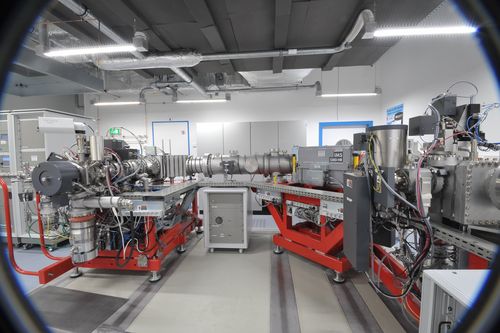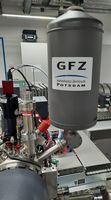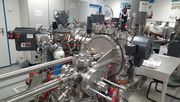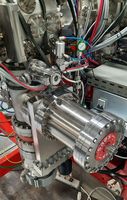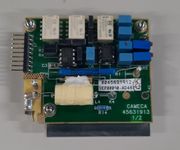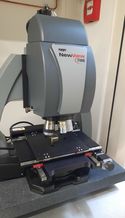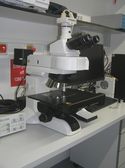SIMS Cameca 1280-HR
Our facility's core instrument is a Cameca 1280-HR mass spectrometer (s/n 23) which was delivered in March 2013. It is equipped with a 5 trolley multi-collection system, which can have up to 5 electron multipliers or 5 Faraday cups. We also have a Resistive Anode Encoder for mapping the distribution of low concentration elements. We have an up-graded vacuum system, including oil-free roughing pumps, a vibration damped 550 l/s turbo pump on the sample chamber and an NMR field controller for high stability magnetic field control during multi-collection analyses. This instrument is housed in a thermally stabilized laboratory which has a temperature range of only +/- 0.3 C. For most applications instrument operation is done from an adjoining room via a desktop duplication system.
The Potsdam1280-HR has been demonstrated to be one of the most stable such instruments world-wide for isotopic ratios determinations, having achieved a repeatability on d18O determinations of 0.09 ‰ over 17 hours of automatic data collection (N = 100). We interpret this excellent level of performance as partly due to the careful detail and innovative design elements that were incorporated during the facility's planning. An overview of our laboratory design was presented the 7th Biennial Geo-SIMS Workshop held in August 2013. <Download powerpoint presentation>
1280 Instrument Upgrades
Large Liquid Nitrogen Tank
The 1280 is designed with a liquid nitrogen tank which cools a gold-plated ring located within the instrument's sample chamber -- this is used to freeze out volatile gas contaminants that are present in the chamber, including water vapor released from the sample mount. The LN2 tank delivered with the instrument has only enough capacity to maintain low temperatures for roughly 6 hours. In 2014 we replaced this tank with a 7.5 liter tank produced by an outside vendor that can remain cool for up to 80 hours. This greatly improves the operation capabilities of our instrument, allowing for unattended operation over the weekend with the tank cooled, significantly suppressing the formation of hydride molecules in our mass spectra. The cooling cannot be used when oxygen flooding is needed -- when we need to warm the tank we have a compressed nitrogen gas from our building's supply which can be delivered via a flexible tygon hose.
12 Position Sample Carousel
One of the specializations of the Potsdam SIMS facility is the quantification of hydrogen abundances at low concentrations. The hydrogen background signal of the 1280 is largely defined by the quality of the vacuum in the sample chamber at the time of analysis. Here one is left struggling with the problem that the sample mount itself, particularly so when it contains significant amounts of epoxy, releases large amounts of water vapor into the sample chamber. To overcome this challenge we designed and installed a sample storage chamber that can accommodate up to 12 samples. By storing an epoxy mount for several week to several months at pressures below 5e-6 Pa, we can greatly reduce the amount of water released into our secondary ion source at the time of analysis. Our bacground hydrogen value on can thus reach values below 10 µg/g for silicates.
2000 l/s NEG Pump
Non-Evaporative Getter Pumps are passive devices that rapidly absorb large amounts of gas from a vacuum system -- they are particularly effective in suppressing H2 and H2O. Beneath the 1280's sample chamber we have installed a 2000 l/s NEG pump from the company SAES Getters. The intent of this modification is to further reduce the hydride background on our mass spectra. Roughly twice per year this device must be heated in order to expel the absorbed gasses; a process that takes only a couple of hours including the regeneration of high vacuum conditions. A large manual gate value has been installed between the NEG cartridge and the SIMS sample chamber, thereby protecting the NEG module from the large amounts of gas that are present when we use oxygen flooding.
e12 Ohm Faraday Amplifier
We have purchased from Cameca an e12 Ohm amplifier that can be installed on a Faraday Cup or our choosing. This upgrade allows us to access secondary ion count rates in the range 500,000 to 2,000,000 ion per second, which is an intensity range that is otherwise difficult to precisely determine. Applications include determining 17O and 33S count rates on silicates and sulphides, respectively. This capability also allows us to work with lower primary beam intensities when particularly high spatial resolution is required.
Peripheral Instrumentation in the Potsdam SIMS Lab
In addition to our SIMS tool we also have other instruments which support our operation.
White Light Optical Profilometer: ZYGO New View 7100 Without making any contact with the sample surface, this instrument can determine surface topography with a spatial resolution of 500 nm in X and Y and 0.5 nm in Z. Our instrument can also determine the depth of SIMS profiles and the surface roughness parameters both of the original sample and the regions that have been sputtered with the SIMS primary beam. It can also calculate the absolute volume of a SIMS crater from which the test portion mass of the method can be derived. Sample flatness and tilt parameters over larger areas can be measured using an image stitching function, allowing us to image an entire SIMS mount if needed. An analysis involves moving the measurement head vertically at an exactly controlled rate, with the total travel usually between 20 and 100 µm. A single measurement typically requires around 40 seconds. We have a total of four objectives mounted on the profilometer’s turret: 1.7x, 10x, 50x and 100x -- these give fields of view ranging from roughly 6 mm down to 100 µm. <Download example of profilometer data>
Motorized Optical Microscope: Nikon Eclipse Many stable isotope analyses (e.g., d18O determinations on silicates) can be completed by the 1280-HR tool in a matter of few minutes. This means that the actual moving of the SIMS sample stage and centring of individual points, typically taking a minute or two per point, becomes a significant factor influencing the overall data production rate. We have a fully motorized in X-Y-Z optical microscope which is being developed for off-line coordinate pre-selection. A sample mounted in a SIMS sample holder is placed under the microscope and the locations of up to several hundred points can be defined, thereby saving a large amount of SIMS instrument time. Also, thanks to the motorized Z-axis, it is possible to create 3-dimensional topographic maps of a sample surface. This microscope's filed of view ranges from roughly 12 mm to 200 µm, depending on which objective us in use.
Gold Sputter Coater: Edwards Scancoat Six SIMS analyses using the 1280-HR instrument require the sample to be electrically conductive. As most geological materials (e.g., silicates, carbonates, phosphates) are electrical non-conductors, it is necessary to coat our samples with a conductive thin film prior to placing the sample in the SIMS sample holder. Our gold coater is able to coat up to 3 samples simultaneously, requiring around 15 minutes for the complete vacuum pump-down and coating operation. Our Edwards gold coater monitors the coating thickness during the process. For most SIMS applications we use a 35 nm thick gold coat. The system is pumped by an oil-free scroll pump and is supplied by house argon.
Vacuum Oven: Heraius Vacutherm The quality of the SIMS vacuum depends strongly on minimizing the presence of water molecules adhering to surfaces within the 1280-HR vacuum system. Of particular importance is an ability to keep H2O away from the primary ion sources. Our vacuum oven can be maintained at a few mbar pressure, which we flush occasionally with dry nitrogen. Storing our reserve duoplasmatron ion source at 40° C under such dry conditions reduces contaminants in our oxygen primary ion beam.
Other Infrastructure available at the GFZ
Electron Microprobes: The GFZ has two Jeol electron microprobes, one using a field emission electron source and the second operating with a LaB6 electron emitter. These are used both for quantitative analysis as well as imaging at the micrometer or sub-micrometer spatial scales. A specialty of the EPMA facility is the quantification of light element concentrations using large lattice spacing defraction crystals.
Scanning Electron Microscope: Section 4.1 of the GFZ operates a Zeiss Ultra 55 Plus field emission SEM. It is able to image at spatial resolution reaching down to low nanometer range and can also operate in low vacuum mode. It is equipped with an EDS and a monochromatic CL detector.
Focused Ion Beam Tools: Two FIB instruments are available at the GFZ which are capable of imaging and milling of polished sample specimens at spatial precisions reaching down to the low nanometer range.
Sample Preparation Facilities: The GFZ has a wide spectrum of sample preparation laboratories capable of working with nearly all solid geomaterials. Specifically within Section 3.1, we have facilities dedicated to rock crushing and milling, mineral extraction and thin section and grain mount preparation.
High Pressure Development Laboratory / Machine Shop: The SIMS Laboratory works closely with the High Pressure Development Laboratory within Section 4.3. This cooperation not only supports the smooth operation of the SIMS facility but also uses the HPDL's expertise in CAD-based designing of new parts in conjunction with a wide variety of both computer controlled and manually operated machining tools.

